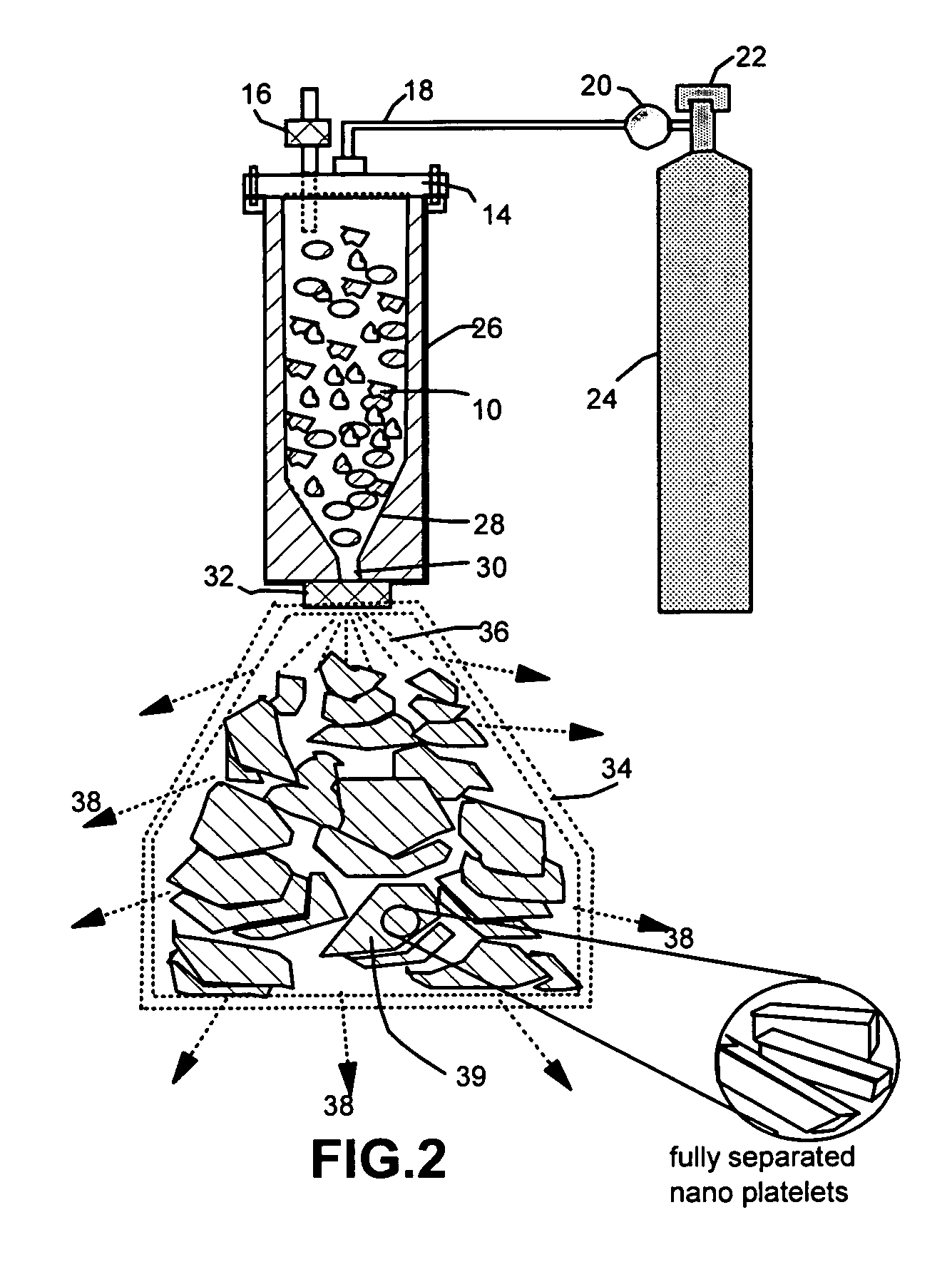Mass production of nano-scaled platelets and products
a technology of nano-scale platelets and products, applied in the direction of single-layer graphene, silicate, silicon compounds, etc., can solve the problems of high material cost, tedious washing step, and high cost of cnts, and achieve the effect of reducing the intercalation tim
- Summary
- Abstract
- Description
- Claims
- Application Information
AI Technical Summary
Benefits of technology
Problems solved by technology
Method used
Image
Examples
example 1
Nano-Scaled Graphene Platelets (NGPs) from Graphite Flakes
[0051]One hundred grams of natural graphite flakes ground to an average size of approximately 2.3 μm were sealed in a helium gas-filled steel container (the intercalation chamber schematically shown in FIG. 2) at 150° C. and 16 atm for 20 minutes to yield the desired gas-intercalated graphite (GIG). Subsequently, the exit valve was opened to expel the GIG out of the chamber. The GIG was exfoliated to a good extent with an expansion ratio (exfoliated flake thickness / GIG flake thickness) of approximately 12 / 1 to 26 / 1. The thickness of individual platelets was found to range from single graphene sheet to approximately 20 graphene sheets. A small portion of the exfoliated graphite particles were then ball-milled in a high-energy plenary ball mill machine for 24 hours to produce nano-scaled particles with reduced length and width (now 0.5-2 μm).
example 2
NGPs from Short Carbon Fibers
[0052]The procedure was similar to that used in Example 1, but the starting material was carbon fibers chopped into segments with 0.2 mm or smaller in length prior to the gas intercalation treatment. The diameter of carbon fibers was approximately 12 μm. An exfoliation ratio of 6 / 1-8 / 1 was observed after being discharged from the exit nozzle.
example 3
NGPs from Graphitic Nano-Fibers (GNFs)
[0053]A powder sample of graphitic nano-fibers was prepared by introducing an ethylene gas through a quartz tube pre-set at a temperature of approximately 800° C. A small amount of Cu—Ni powder was positioned on a crucible to serve as a catalyst, which promoted the decomposition of the hydrocarbon gas and growth of GNFs. Approximately 2.5 grams of GNFs (diameter of 10 to 80 nm) were intercalated with a mixture of hydrogen and helium gases at approximately 12 atm and 150° C. for 30 minutes and then to 200° C. at 10 atm for additional 10 minutes. After discharge from the chamber, the intercalated particles were found to be exfoliated to a great extent (without an expansion ratio measurement). A large number of single- or double-layer graphene discs of 10-80 nm in diameter and 0.34 or 0.68 nm in thickness were obtained.
PUM
| Property | Measurement | Unit |
|---|---|---|
| Temperature | aaaaa | aaaaa |
| Thickness | aaaaa | aaaaa |
| Thickness | aaaaa | aaaaa |
Abstract
Description
Claims
Application Information
 Login to View More
Login to View More - R&D
- Intellectual Property
- Life Sciences
- Materials
- Tech Scout
- Unparalleled Data Quality
- Higher Quality Content
- 60% Fewer Hallucinations
Browse by: Latest US Patents, China's latest patents, Technical Efficacy Thesaurus, Application Domain, Technology Topic, Popular Technical Reports.
© 2025 PatSnap. All rights reserved.Legal|Privacy policy|Modern Slavery Act Transparency Statement|Sitemap|About US| Contact US: help@patsnap.com



